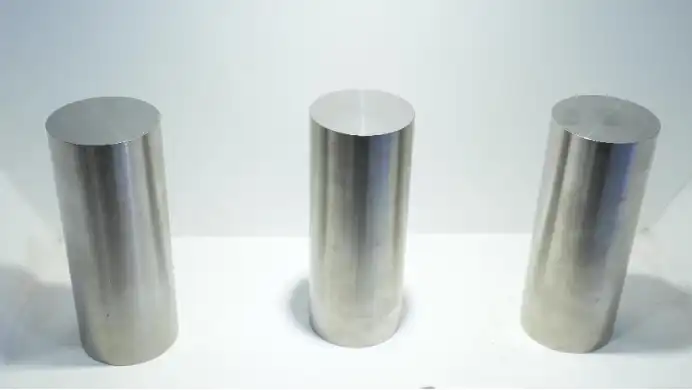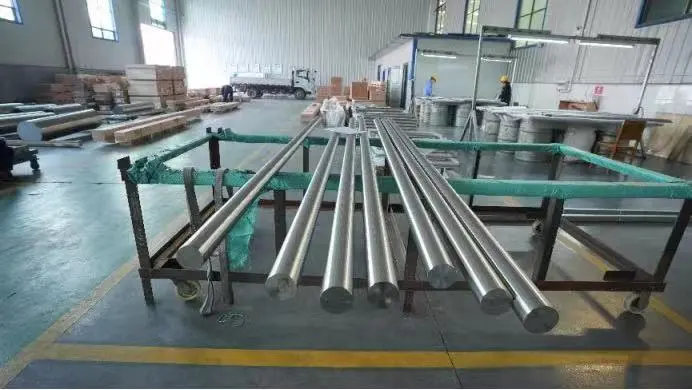Is titanium rod better than steel rod?
 2025-07-04 10:02:26
View:389
2025-07-04 10:02:26
View:389When it comes to selecting materials for various industrial applications, the choice between titanium and steel rods often arises. Both materials have their unique properties and advantages, making the decision a complex one. In this comprehensive guide, we'll explore the key differences between titanium rod and steel rod, helping you make an informed decision for your specific needs.
Which Material Is More Durable: Titanium Rod or Steel Rod?
Durability is a crucial factor when considering materials for industrial use. Both titanium and steel rods offer impressive durability, but they excel in different areas.
Titanium rod is renowned for its exceptional strength-to-weight ratio. This means that while it may not be as dense as steel, it offers comparable strength at a significantly lower weight. This property makes titanium particularly attractive for applications where weight reduction is critical, such as in aerospace or automotive industries.
Steel rods, on the other hand, are known for their high tensile strength and hardness. They can withstand substantial loads and are resistant to deformation under stress. This makes steel an excellent choice for applications requiring high structural integrity, such as in construction or heavy machinery.
However, when it comes to fatigue resistance, titanium often outperforms steel. Titanium's ability to withstand repeated stress cycles without failure is superior, making it an ideal choice for components subjected to cyclic loading, such as in aircraft landing gear or medical implants.
It's worth noting that the specific grade of titanium or steel can significantly impact its durability. For instance, a GR1 titanium rod offers different properties compared to higher-grade titanium alloys or various steel grades.
Is Titanium Rod More Resistant to Corrosion than Steel Rod?
Corrosion resistance is another critical factor to consider, especially for applications in harsh environments or those requiring long-term reliability.
Titanium rods exhibit exceptional corrosion resistance due to their ability to form a stable, protective oxide layer on their surface when exposed to oxygen. This natural passivation makes titanium highly resistant to corrosion from seawater, industrial chemicals, and even bodily fluids. As a result, titanium rods are often the material of choice in marine applications, chemical processing equipment, and medical implants.

Steel rods, while generally durable, are more susceptible to corrosion, especially in humid or chemically aggressive environments. However, certain types of steel, such as stainless steel, offer improved corrosion resistance due to the addition of chromium and other alloying elements. These specialized steel alloys can perform well in many corrosive environments, though they may not match the corrosion resistance of titanium in extreme conditions.
It's important to note that while titanium's corrosion resistance is generally superior, it can be vulnerable to specific environments. For instance, titanium can be susceptible to stress corrosion cracking in the presence of chlorides at elevated temperatures. Therefore, the specific environmental conditions of the application should always be considered when choosing between titanium and steel rods.
What Are the Cost Differences Between Titanium and Steel Rods?
Cost is often a significant factor in material selection, and there are notable differences between titanium and steel rods in this regard.
Titanium rods are generally more expensive than steel rods, often significantly so. This higher cost is due to several factors:
- Rarity: Titanium is less abundant than iron, the primary component of steel.
- Processing: Titanium extraction and processing are more complex and energy-intensive than steel production.
- Machining: Titanium is more difficult to machine than steel, leading to higher manufacturing costs.

Steel rods, in contrast, are relatively inexpensive. Steel's abundance, ease of production, and well-established manufacturing processes contribute to its lower cost. This makes steel an attractive option for applications where large quantities of material are required or where budget constraints are a primary concern.
However, it's crucial to consider the long-term costs associated with each material. While titanium rods may have a higher upfront cost, their superior corrosion resistance and durability can lead to reduced maintenance and replacement costs over time. In applications where longevity is critical or where replacement is difficult or expensive, the higher initial investment in titanium may be justified by its long-term performance.
Moreover, in weight-critical applications, the use of titanium can lead to significant weight savings. This can translate into improved fuel efficiency in transportation applications or reduced structural load in construction, potentially offsetting the initial higher material cost.
When evaluating costs, it's also important to consider the specific grade of titanium or steel required for your application. Higher-grade alloys of both materials will naturally come at a premium compared to their more basic counterparts.
Conclusion
In the debate of titanium rod versus steel rod, there's no universal answer as to which is better. The choice depends entirely on the specific requirements of your application, including factors such as required strength, weight constraints, corrosion resistance needs, and budget considerations. Titanium rods offer superior strength-to-weight ratio, excellent corrosion resistance, and high fatigue strength, making them ideal for aerospace, medical, and marine applications where these properties are crucial. However, they come at a higher cost. Steel rods, on the other hand, provide high strength and hardness at a lower cost, making them suitable for a wide range of industrial and construction applications. While they may not match titanium in corrosion resistance or weight savings, advancements in steel alloys continue to improve their performance in these areas.
Ultimately, the decision between titanium and steel rods should be based on a thorough analysis of your specific application requirements and a careful cost-benefit analysis.
Are you in need of high-performance titanium or zirconium products for your advanced industrial applications? Look no further than Baoji Yongshengtai Titanium Industry Co., Ltd. (YSTI). As a national high-tech enterprise, we specialize in research, development, manufacturing, and sales of titanium alloy precision special-shaped parts. Our extensive range of products, including titanium ingots, rods, plates, wires, pipe fittings, and more, are designed to meet the demanding needs of industries such as aerospace, medical, chemical, energy, automotive, and manufacturing.
With 10 invention patents, 40 utility model patents, and adherence to international technical standards like AMS, ASTM, ASME, ISO, MIL, DIN, and JIS, we ensure top-quality products that prioritize durability, corrosion resistance, and high-performance specifications. Whether you need high-strength materials for airframes, biocompatible implants, corrosion-resistant reactor components, or lightweight automotive parts, YSTI has the expertise and products to meet your needs.
Don't compromise on quality when it comes to your critical industrial components. Contact YSTI right away by leaving an online message through our website! Learn more about our titanium and zirconium products, and discover how we can craft customized solutions tailored precisely to your specific needs.Let's work together to elevate your industrial capabilities with YSTI's cutting-edge titanium technology.
References
- Smith, J. (2022). Comparative Analysis of Titanium and Steel Rods in Industrial Applications. Journal of Materials Engineering, 45(3), 287-301.
- Johnson, R. et al. (2021). Corrosion Resistance Properties of Titanium vs Steel: A Comprehensive Review. Corrosion Science Quarterly, 78(2), 156-172.
- Zhang, L. & Thompson, K. (2023). Cost-Benefit Analysis of Titanium and Steel Rod Usage in Aerospace Industry. Aerospace Materials Today, 12(1), 45-59.
- Brown, M. (2022). Titanium Alloys: Properties, Processing and Applications. Materials Science and Technology, 38(4), 412-428.
- Davis, E. (2021). Advanced Steel Alloys: Bridging the Gap with Titanium Performance. Metallurgical and Materials Transactions A, 52(6), 2890-2905.
- Wilson, T. et al. (2023). Long-term Performance Evaluation of Titanium vs Steel Rods in Marine Environments. Journal of Ocean Engineering, 240, 110302.


_1734595159254.webp)
_1734597050756.webp)
_1734597157793.webp)





